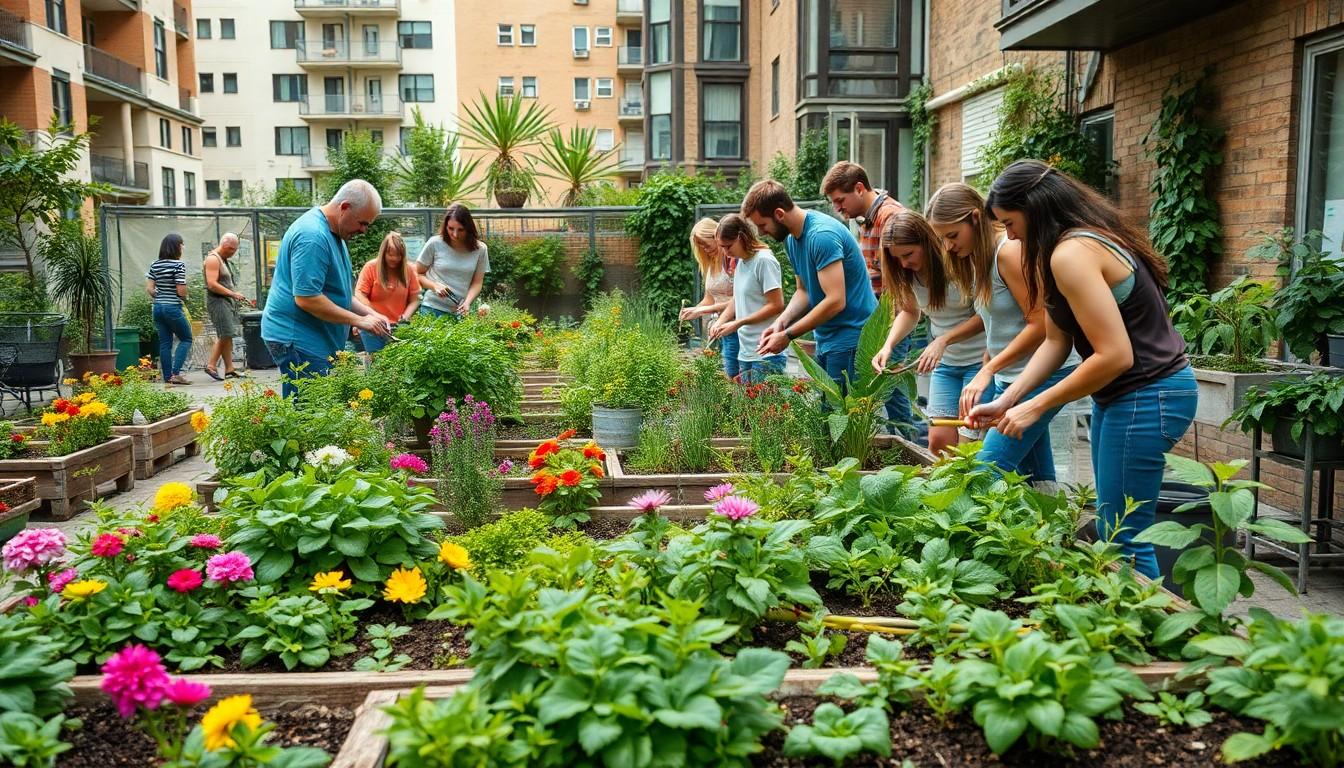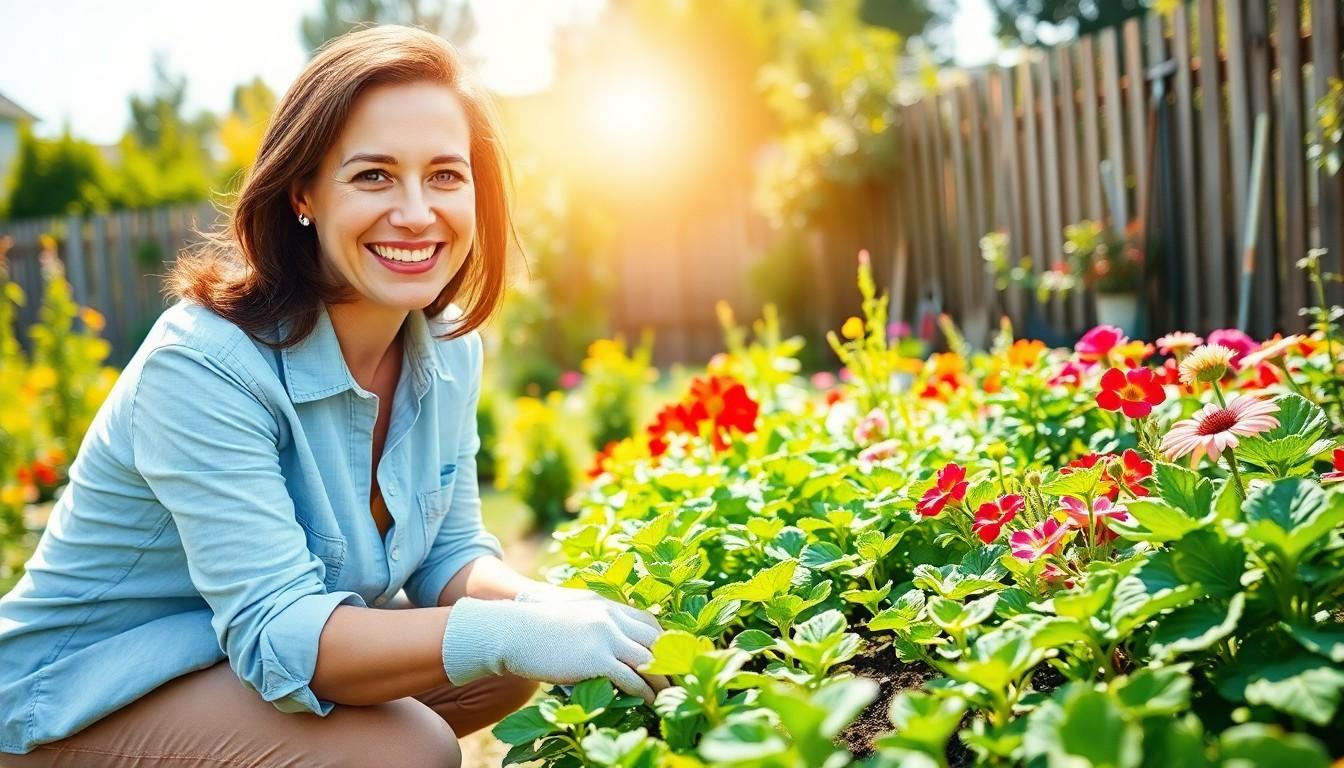Gardening isn’t just a pastime; it’s a delightful blend of art, science, and a bit of dirt under the nails. Picture this: you, a trowel in hand, coaxing life from the soil while dodging the occasional worm. It’s a dance with nature that promises fresh veggies, vibrant flowers, and a workout that won’t require a gym membership.
What Is Gardening?
Gardening encompasses the cultivation and management of plants for aesthetic, nutritional, and ecological purposes. It combines creativity with practicality, allowing individuals to express themselves through landscape design while also fostering sustainability. The process involves preparing the soil, selecting suitable plants, and ensuring proper care, which includes watering, weeding, and harvesting.
Numerous types of gardening exist. Urban gardening caters to city dwellers, focusing on small spaces and containers. Organic gardening emphasizes the use of natural methods and avoids synthetic chemicals. Landscape gardening enhances outdoor areas, employing design techniques to create inviting spaces.
Gardening provides multiple benefits. It promotes physical activity, reducing stress and improving overall health. Engaging with plants can enhance mood and foster a sense of accomplishment. Growing produce at home can lead to better nutrition and cost savings.
Individuals can practice gardening at various scales. Small indoor gardens offer a space for herbs and ornamental plants. Larger outdoor gardens can feature flowers, vegetables, or even fruit trees, catering to diverse preferences. Accessibility allows nearly anyone to participate, regardless of experience level.
To get started, gather essential tools such as trowels, gloves, and watering cans. Research local climate conditions to choose appropriate plants. Consider soil quality and light exposure for optimal growth. Community gardens provide opportunities for shared resources and knowledge, encouraging social interaction and collaboration.
Gardening stands as a rewarding pursuit, combining elements of care, creativity, and science. The simple act of nurturing life contributes to well-being while enhancing the environment. Each garden tells a unique story, reflecting the gardener’s personal journey and values.
Types Of Gardening

Gardening takes many forms, each catering to different preferences and environments. Understanding these types enhances the gardening experience.
Outdoor Gardening
Outdoor gardening focuses on cultivating plants in external spaces. It can range from large plots in backyards to small patio arrangements. Various plants, including flowers, vegetables, and herbs, thrive in these environments. Seasonal changes significantly influence outdoor gardening; gardeners select plants that flourish in specific climates. Techniques such as raised beds, container gardening, and permaculture offer diverse methods for maximizing growth. Maintaining soil health and implementing crop rotation promotes sustainability and yields.
Indoor Gardening
Indoor gardening emphasizes growing plants within residential spaces. Limited light conditions prompt the use of grow lights for optimal plant health. Many choose houseplants, herbs, or even small vegetables for culinary use. Space-saving techniques like vertical gardening utilize walls effectively. This type of gardening also benefits from humidity trays or water globes to maintain moisture levels. Additionally, it decorates and purifies indoor air, improving overall living conditions.
Community Gardening
Community gardening fosters collaboration among local residents. Shared spaces encourage social interaction and knowledge sharing. Participants often cultivate various plants, enhancing biodiversity within urban settings. Community gardens provide access to fresh produce, promoting nutrition and wellbeing among members. Many projects focus on sustainability, incorporating composting and organic practices. Involvement offers educational opportunities for all ages, creating a sense of belonging and responsibility within neighborhoods.
Benefits Of Gardening
Gardening offers a wide array of benefits, enhancing both physical and mental well-being. Engaging in this activity nurtures various aspects of health, reflecting the holistic advantages of working with nature.
Physical Health Benefits
Physical activity is a cornerstone of gardening. Digging, planting, weeding, and harvesting contribute to cardiovascular health and muscle strength. Studies show an hour of gardening can burn 200 to 400 calories, depending on intensity. Fresh produce from a home garden contributes essential vitamins and minerals to the diet. Eating organic fruits and vegetables lowers exposure to chemicals found in store-bought options. Regular gardening fosters flexibility and endurance, especially with tasks that require bending and lifting. Engaging in gardening lowers risks associated with sedentary lifestyles, promoting longevity and vitality.
Mental Health Benefits
Gardening significantly affects mental health. Studies indicate that spending time with plants reduces anxiety and depression. The act of nurturing plants fosters a sense of purpose, leading to increased satisfaction. Gardening encourages mindfulness, allowing individuals to focus on the present moment, which has calming effects. Connecting with nature enhances mood and boosts self-esteem. Observing plant growth and seasonal changes provides joy and a sense of accomplishment. Community gardening strengthens social connections, reducing feelings of isolation and loneliness, contributing positively to mental wellness.
Gardening Techniques
Gardening techniques vary widely, allowing for creative expression and practicality in cultivating plants.
Organic Gardening
Organic gardening emphasizes natural methods for growing plants. This approach avoids synthetic chemicals and genetically modified organisms. Instead, it uses compost, natural fertilizers, and eco-friendly pest control methods. Many gardeners practice crop rotation to enhance soil health and prevent disease. Cover crops, such as clover or rye, can improve soil fertility and structure. Utilizing companion planting encourages biodiversity, allowing certain plants to thrive together. Vegetables like tomatoes benefit from growing alongside basil, which repels pests. Organic gardening not only produces healthier crops but also contributes to a sustainable environment.
Hydroponic Gardening
Hydroponic gardening involves growing plants without soil, using nutrient-rich water instead. This technique maximizes space and allows for faster growth. Systems include nutrient film technique, aeroponics, and deep water culture. These methods enable gardeners to cultivate plants indoors or in controlled environments. Hydroponics minimizes water usage by recycling water in a closed-loop system. Leafy greens and herbs thrive in hydroponic setups, providing fresh produce year-round. Many urban gardeners appreciate hydroponics for its efficiency, making it an attractive option for those with limited space.
Gardening Tools And Equipment
Essential gardening tools and equipment enhance the gardening experience. A trowel, for instance, makes planting and digging efficient. Various types of trowels suit different tasks, such as transplanting seedlings or digging narrow holes.
Pruning shears offer precision and control for shaping plants. Gardeners use bypass or anvil shears based on their specific needs. Rakes play a crucial role in leveling soil and collecting debris, aiding in garden maintenance.
Watering cans and hoses are vital for keeping plants hydrated. A watering can provides targeted hydration, while hoses with adjustable nozzles cover larger areas effectively. Fertilizer spreaders simplify the application of nutrients, ensuring plants receive essential elements for growth.
Gloves protect hands from thorns and dirt while providing a better grip. Various materials, including leather and rubber, offer options based on gardening needs. Garden carts facilitate the transport of tools, plants, and soil, making the work process smoother.
Additionally, tools like wheelbarrows assist in moving heavier loads. Shovels hold multiple uses, from digging holes to turning compost. Hand tools, like weeders and cultivators, effectively manage weeds and aerate the soil, promoting healthy growth.
Gardening stakes and trellises support climbing plants, maximizing garden space. Plant labels help gardeners identify various species, aiding in garden organization. Selecting the right tools and equipment contributes significantly to successful gardening practices.
Conclusion
Gardening is a fulfilling endeavor that merges creativity with practicality. It offers numerous benefits that extend beyond the physical act of planting and nurturing. By engaging with nature, individuals can improve their mental health while enjoying the fruits of their labor.
Whether it’s a small indoor setup or a sprawling outdoor garden, the possibilities are endless. The journey of gardening reflects personal values and fosters a deeper connection to the environment. With the right tools and techniques, anyone can embark on this rewarding path and experience the joy that comes from cultivating life.





